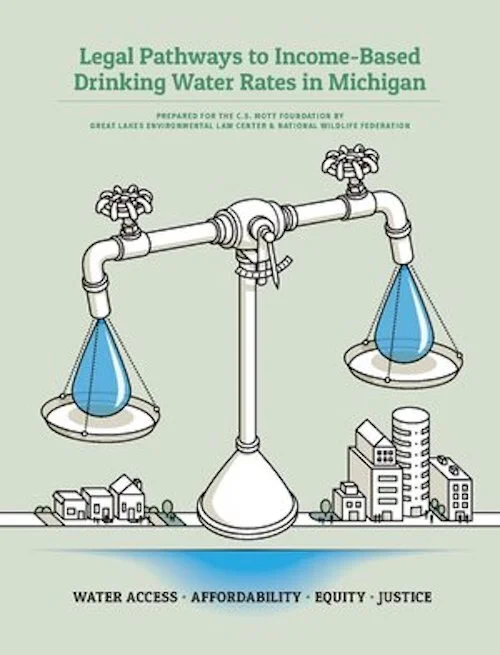Resources
Published in 2020
Michigan lead and copper rule Handbook: Empowering resident watchdogs to Conduct investigations of their water systems
The Flint Water Crisis was initially identified not by water system operators or government officials, but by resident watchdogs that continued to raise the alarm despite being constantly told that their water was safe to drink. Now, with increased monitoring resulting in more communities finding elevated levels of lead in drinking water, many other Michiganders across the state are wondering if their water is safe to drink, cook, and bathe with.
Unfortunately, the Michigan Lead and Copper Rule, which is the primary regulation controlling lead in drinking water, is very complex. This Handbook has been created to help residents understand what the Michigan Lead and Copper Rule requires, and how residents can engage with the Michigan Department of Environment, Great Lakes, and Energy as well as their local water department to get answers to their questions. It also provides over 20 sample Freedom of Information Act Requests and over 30 watchdog actions that residents can pursue to get the answers they need.
Published in 2020
Legal pathways to income-based drinking water rates in Michigan
As thousands of residents in communities such as Detroit and beyond have confronted the reality of being unable to afford drinking water, they have advocated to their local governments and water departments to establish income-based water rates to ensure that all residents can afford running water, regardless of their income However, in Michigan these calls have been consistently rejected on the grounds that such a rate would violate Michigan law, in particular the Michigan Constitution’s Headlee Amendment, which requires local governments to obtain voter approval before enacting or increasing any tax.
This report evaluates the legal validity of income-based water rates in Michigan, and concludes that such a rate structure would not violate the Headlee Amendment or any Michigan law. It also describes how local governments in Michigan have routinely authorized lower rates or discounts for municipal services, including sewer and garbage collection services, for certain classes of people, such as the elderly and those facing economic hardship.
Published in 2019
Protecting Drinking Water in the Great Lakes: A Primer on Existing State Policies and Using the safe drinking water Act
While the federal Safe Drinking Water Act establishes national standards for drinking water protection from public water supplies, states are free to establish protections that are more stringent than the federal standards.
In partnership with American Rivers, the Great Lakes Environmental Law Center published this report to compare how the 8 Great Lakes states are addressing 10 drinking water issues impacting the region. The 10 drinking water issues covered by the report are:
Maximum contaminant levels, treatment techniques, and monitoring standards
Lead as a drinking water contaminant
Consumer confidence reporting
Loans and grants
Public participation in standards, permits, and enforcement
Operator certification
Management of drinking water emergencies
Management of algal blooms and their consequences
Private water supplies: well construction and protection from pollution
Per- and Polyfluoroalkyl Substances (PFAS) and Drinking Water
Published 2019
Vegetative Buffers and Tree Canopy: Promoting the use of trees to improve local air quality with local policy
In partnership with a team of multi-disciplinary Masters students from the University of Michigan, the Great Lakes Environmental Law Center developed this report detailing how local governments can promote the development of increased tree canopy and vegetative buffers to improve local air quality and public health.
The report integrated case studies from leading cities, insights from a community engagement workshop in Detroit, and modeled the implementation of increased tree canopy and vegetative buffers at three Detroit sites.
Published in 2018
Furthering Environmental Justice in Air quality enforcement with supplemental environmental projects
In Michigan, the penalties assessed against a violator of an environmental law or regulation go to the state general fund. This leaves the communities that have been directly impacted by the emissions or discharges that impact their quality of life with no redress for the harm they have suffered.
“Supplemental environmental projects” are environmentally beneficial projects that a violator may agree to undertake as part of the terms of an enforcement action that is initiated due to a violation of some environmental quality standard. If properly implemented, they can provide the people that are impacted by illegal emissions or discharges with redress for the harm they have suffered.
Unfortunately, Michigan’s policy regarding “supplemental environmental projects” creates a disincentive for violators to agree to conduct such projects. This report:
Describes how supplemental environmental projects may be used to further environmental justice
Compares Michigan’s policy to the U.S. EPA’s policy, as well as several other state policies.
Identifies obstacles to the robust use of supplemental environmental projects as a tool to further environmental justice in enforcement, and provides recommendations for revisions to Michigan’s policy





